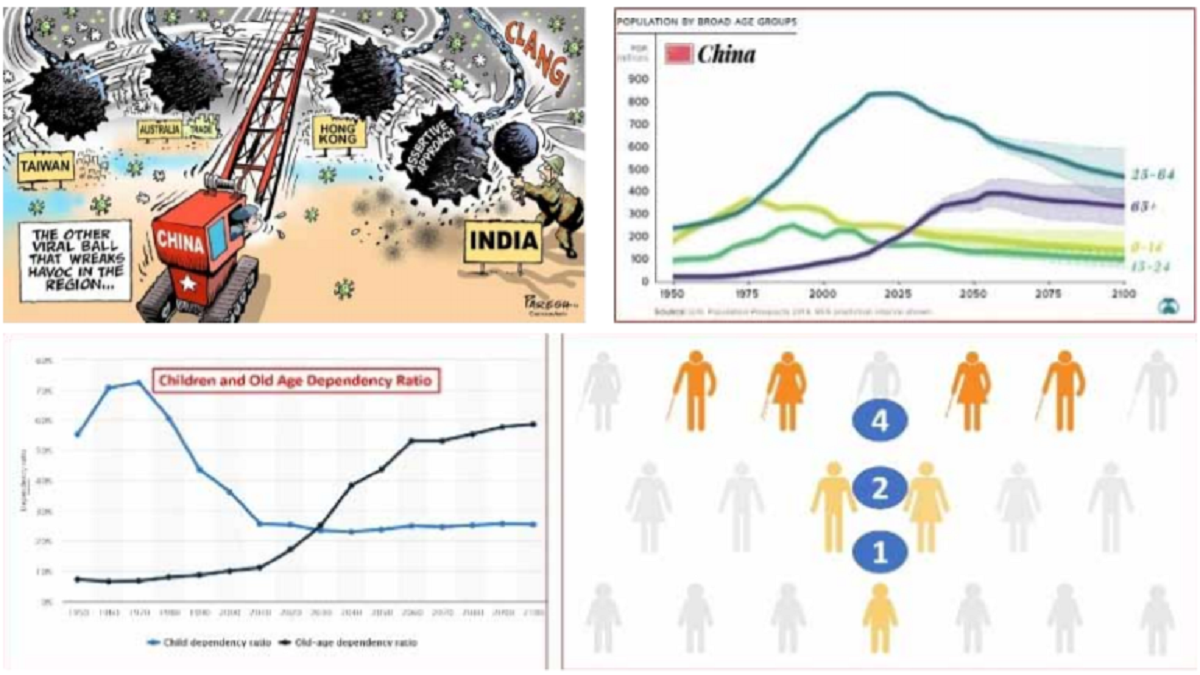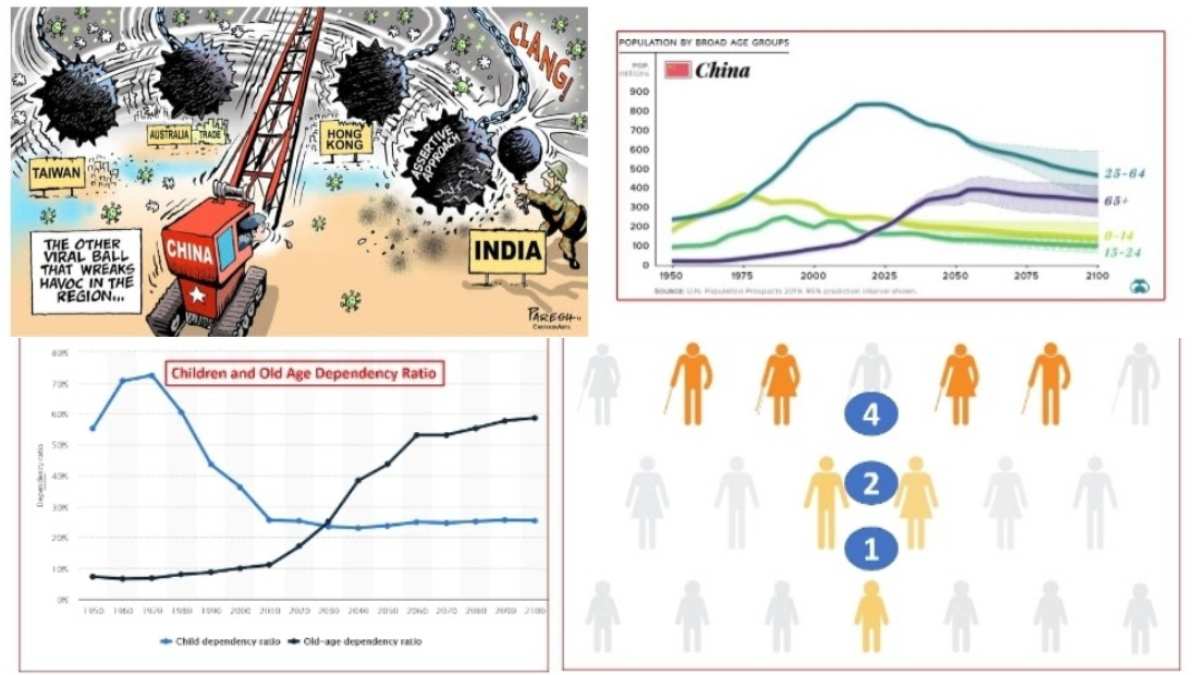China is not the middle kingdom It is the middle-aged kingdom Why is China doing what it is doing? Two recent articles highlight the dichotomy of the situation. The article ‘China Talks of US Decoupling and a Divided World’ highlights the views of Zhou Li, a high ranker in CCP. He cautions China to prepare for shrinking external demand, disruption of supply chains, coexistence with coronavirus over the long term, an outbreak of a global food crisis (in China?) and a resurgence of international terrorism (Tibetan and Uighur?). The Chinese economy is painted grim due to reduced exports, stalled production, blocked international logistics, raw materials lacking, and low productivity. Stable growth and job security are under high pressure. The other article talks of China’s Unconventional Levers of Power in World Affairs. The unconventional levers include building and exploitation of economic dependence, unfair practices, influence operations, capture of the elite, coercion through minimal force application but maximum reprisal promise, capture of international communication enterprises and creeping territorial expansion.
Things do not add up. A wannabe superpower with a grim economic outlook does not go around antagonising its neighbors without a reason. We need to look elsewhere.
Historical perspective
Recent Chinese History (1899 onwards) has five clear cycles. Significant events of each cycle are listed.
The Chaotic Cycle (1899- 1948): Boxer Rebellion against the waning Manchu Qing Dynasty, Beiyang warlordism , Rise of Nationalists, End of imperialism, Proclamation of Republic of China , Rise of Communists, Japanese invasion, Long March by Mao (1934-35), Civil war, and Famine (10 million dead).
Mao’s Great Leap Cycle (1949-76): Annexation of Tibet, Great Leap Forward, Greatest Manmade famine (36-40 million dead), Sino Indian War, 10-years of Cultural Revolution, Nixon’s visit and Economic reforms.
Deng’s Consolidation Cycle (1977- 97): Open-door policy, Four Modernizations, One-child policy, Vietnam War, Tiananmen Square incident, Reversion of Hong Kong reverts, One country two systems, Third largest economy and Superpower aims by 2050.
The Cycle of Rise (1998- 2013): Second largest economy, Joining WTO, World’s biggest exporter, Space entry, ASAT capability, Beijing Olympics, and Weathering global financial crisis. Aging demographics surface.
The Overheated Expansion Cycle (2013 till date): Xi’s lifetime presidency, efficiency and anti-corruption drive, cooling economy, BRI and CPEC , Made in China 2025, Military expansion and modernisation, Trade war, South China Sea claims, Wuhan Virus outbreak, Hong Kong crisis, and Sino-Indian crisis.
Standout issues: Chinese sense of superiority is historical. It spurs the national ambition of attaining Superpower status. Deng set that to happen in 2050. The current cycle has seen extraordinary expansion of Chinese economic, military, and political power. The ‘China Dream’ of being a superpower was preponed to be achieved by 2030. Prima facie it seems over ambitious. Till one sees the demographics. Also, the popular thinking that China has a long-term strategic view of things is a myth not borne by its history. The past century has been cycles of selfhumiliation, internal strife, and revisionism where the state has promised prosperity and nationalism for surrender of personal liberties.


China’s large population, is aging fastest due to falling birth rates and rising life expectancy (see graph). Chinese birth rates are the lowest for 70 years despite easing the one-child policy. China has approximately 24 million marriageable males without brides. It explains bride trafficking from Pakistan! Its population is predicted to peak at 1.4 billion. Working hands and taxpayers are decreasing. Overall dependency is increasing. A smaller working-age population must support a bigger, retired population. Social security net is minimal in China. Every working Chinese must support two parents and four grandparents. Commonly known as the 4-2-1 phenomenon. China’s economic growth was based on labor-intensive manufacturing . The drop in labor force, increases labor costs, makes goods less competitive.
Race against time
The Middle-Aged Kingdom will get old before it gets rich. Beyond 2030, China’s economic growth faces a cap, when the overall dependency ratio starts spiking. If China must be a superpower, it must get rich before it becomes old and decline sets in. It is a race against time to 2030.
The ‘get rich before old scheme’ has four drivers. One, productivity-enhancing reforms to snare the rich and lazy as well as the poor and unable. Create inalienable dependence through a data driven manufacturing web. Two, the BRI and CPEC; which debt trap poorer countries. A slumlord mentality to garner money and power at the bottom of the heap. Three, the ‘Made in China 2025 Plan’, which envisages transformation of a low end ‘Made in China’ label to the high end ‘Create in China’ symbol. Ten core areas were targeted for technological ascendancy and high value returns. Huawei was part of this drive. Four, build a world class military to protect its interests and sort out rivals. The first driver is the basic one. The others rest on that. Incidentally the only two big economies with better demographics are the US and India. They are China’s chief threats! Logical so far?
Everything was going great. Purring smoothly on track barring the small blip of a ‘Trade War’. Till the Wuhan Virus hit everyone for a six.
Enter the virus:
China realized the lethality of Wuhan Virus by midJanuary. China was being setback irretrievably. On 25 January they curtailed internal travel. Something was planned when Xi Jinping was out of public view for about ten days. They ensured International travel continued to carry the Virus out; to flatten the field.
When global supply chains were disrupted, everyone realised that China had surreptitiously created dangerous dependencies. Clamor for decoupling commenced. As the virus spread, the BRI came to a grinding halt. ‘Made in China 2025’ was endangered by an anti-Huawei campaign. Plan Superpower was being broadsided by the Virus.
By the third week of Apr there were calls for hard decoupling. India and ASEAN were at the forefront to reap the relocation dividend. How to save a falling economy? Plan 1: Gobble up attractive assets affected by the global stock market crash. That was resisted internationally. Plan 2: Undermine decoupling. Enable relocation through Chinese investment and tutelage. Only countries like Bangladesh agreed. India was vying for Global Leadership also. Hence Plan 3: India and ASEAN had to be forced into submission to re-establish global dependency on China. Isolation would then automatically end. India, a prime competitor, had to be dealt militarily. Australia, Hong Kong, Taiwan, and others needed different levers. The key: derail relocation/ decoupling through coercive control taking advantage of a weakening US and a divided Europe. The BRI and Made in China 2025 would eventually recover. The ‘Superpower 2030’ plan would go through with some delay.
However any conflict with India could escalate and slow down the economy unacceptably. Hence the Chinese aggression had to be low key, calibrated, but belligerent to assert strategic control politically and economically. The hallmark of the current Sino Indian standoffs is that even till date Chinese deployments are not tactical. All they have tried is to demonstrate force, manufacture victory, talk peace, and re-establish economic control so that India cannot rise. Once that was achieved, the rest would follow suit. In this context, China’s Unconventional Levers of Power in World Affairs makes immense sense. If Galwan action had gone their way, China’s aim would have been achieved. However that was not to be. India stood up and inflicted a bloody nose. China has realised that it has miscalculated. Its superpower ambitions are at stake. It started talking about peace.
The old man’s situation
An isolated China is in a two-front situation with its biggest competitors. PLA is negotiating with the Indian Army after the bruising it received at Galwan. Substantial PLA forces will be tied down till status quo ante is achieved. Three US carrier fleets pivoting around Taiwan in the South China Sea are an overmatch for PLAN. The US is determined to not let China claim the South China Sea as its own. Other nations are aligning to this. Floods in central China, periodic surfacing of the Wuhan Virus, Swine flu and Bubonic plague outbreaks are adding to economic and social problems. Hong Kong’s situation is still volatile. Banning of apps by India and Huawei’s ouster from the UK and USA will have a wider effect on the Chinese information game. Bank runs are surfacing. Bank withdrawals are being limited. Combine it with Zhou Li’s views on economics — jobs, production, exports, logistics, weak consumption. Problems galore.
Back to the virus. It is still raging. As the virus continues some decoupling is automatically happening. People’s habits are changing. In addition, big players like Apple and Microsoft are gravitating towards India. Others will follow. It may appear that other countries are highly infected by the virus and China is better off. However other countries and communities have started coexisting with the virus better. The bulk of the Chinese population is still not affected. Chinese strict lockdowns just kick the can down the road. The problem is still ahead.
In May, Xi Jinping exhorted China to be prepared for the worst-scenarios and PLA to prepare for war. The ‘Chinese Century’ and superpower status by 2030 is receding. This was what he had in mind. Decline of an aging China will be accelerated by lack of international trust. Xi Jinping knows this. That is why he has now written to Global CEOs to say that fundamentals of China’s long term growth will not change. Xi Jinping has not given up on his dream. His last gambit?
Postulates for India
If China declines India must rise. So it is in India’s interests that an aging China declines. Prepare and act accordingly. The odd finger at Pangong Tso is irrelevant. Think beyond that.
India rises despite setbacks and chaos. This is its history. Virus, China, Pakistan, Floods, Earthquakes et al, affect India but cannot stop it. India underestimates its greatest strengths — diversity, vitality, soft power, democracy, assimilation, and trust. India has the skill set to rise. We the people along with the government must capitalise on this.
The Indian Armed Force is strong enough to hold China at bay to let India grow. If they are strengthened, India will grow faster. Respond accordingly.
Dealing with Dragon
While Chinese comprehensive national power is much greater than India’s, it is not overwhelming. On the contrary, India has the power to derail the MiddleAged Kingdom. The following needs to be strategically conveyed and executed.
Altering the status of LAC unilaterally by China is sine qua non. We should not step back. China cannot afford war and is not prepared for it.
1. Do not give any trade concessions to China to appease it. Do not be in a hurry. Do not buckle.
2. Dry out Chinese seepage into our society. Deny data and information to China.
3. Ensure Aatmanirbharta and relocation through wise policy and implementation.
4. Develop international democratic alliances to counter authoritarianism and expansionism.
5. Support democratic movements in Tibet, Xinjiang, Hong Kong and Taiwan.
Lt Gen P.R. Shankar was India’s DG Artillery. He is highly decorated and qualified with vast operational experience. He contributed significantly to the modernisation and indigenisation of Artillery. He is now a Professor in the Aerospace Dept of IIT Madras and is involved in applied research for defence technology. His other articles can be read on his blog www. gunnersshot.com.

